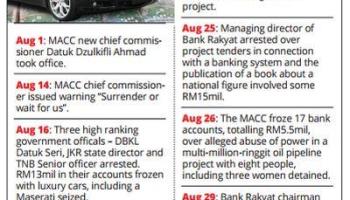New debt crisis a threat to global stability

https://en.wikipedia.org/wiki/Debt-to-GDP_ratio;
The global debt clock: http://www.economist.com/content/global_debt_clock
Global debt has jumped alarmingly to RM631tril and as capital flows out from developing countries, some are facing new debt crises.
DEBT worldwide has grown to unprecedentedly high levels and has to be brought down to prevent another financial crisis.
This was highlighted by the International Monetary Fund at its annual meeting in Washington last week.
Other problems facing the global economy include the stagnation in world trade, a decline in commodity prices and the reversal of capital flows to developing countries.
A recently released United Nations report has analysed the situation as a third phase in the global crisis that began with the United States in 2008, then spread in a second wave to Europe, and is now moving on to the developing countries.
The IMF said that world debt had reached US$152tril (RM631tril), a record level. It was 200% of the value of global gross domestic product in 2002, but has risen to 225% in 2015. The private sector holds two thirds of the total, but government debt has also risen fast, and the IMF warned about the risk of another financial crisis.
“Excessive private debt is a major headwind against global recovery and a risk to financial stability,” said Vitor Gaspar, IMF director of fiscal affairs. “Rapid increases in private debt often end up in financial crises.”
Most of this global debt is concentrated in developed countries. The huge jump there has been due to policies of easy money and low, zero or even negative interest rates, and especially to quantitative easing in which Central Banks bought bonds and pumped trillions of dollars into the banking system.

https://sputniknews.com/europe/201607121042814891-germany-italy-europe-financial-crisis/
It was hoped that this massive infusion would cause the banks to increase lending to consumers and businesses and thus stimulate economic growth.
However, the real economy did not benefit much. Instead, most of the money went into the equity markets, boosting prices, and to the developing economies as investors searched for higher yield, and this helped to fuel the growth of their debt.
The debt of non-financial corporations in emerging economies jumped from US$9tril (RM37tril) at end-2008 to over US$25tril (RM104tril) by end-2015, or from 57% to 104% of their GDP.
Foreigners now own unprecedentedly high shares of bonds and equities in developing countries, which have become vulnerable to investor-mood swings and funds, resulting in financial crises.
When market sentiment or conditions change, the massive inflows can turn into equally large outflows. Indeed, the boom-bust cycle of capital flows has gone through many turns through the years.
Huge amounts left developing countries in the fourth quarter of 2015, and for that year as a whole there was a net outflow of US$656bil (RM2.7tril) or 2.7% of their Gross Domestic Product, according to the UN Conference on Trade and Development (UNCTAD).
This was a big change from a net inflow of 1.3% of GDP in 2013. This turnaround of 4.4% is much larger than the reversals of capital flows in 1981-83, 1996-98 and 2007-08.
But in recent months the cycle turned again, with the return of fund investors to emerging economies. For example, in Malaysia, after suffering large outflows in 2015, there have been net inflows of funds into the equity and bond markets in the past few months.
Going through these cycles, the debt of developing countries has grown. “Easy access to cheap credit in boom times has led to growing debt levels across the developing world,” says UNCTAD’s Trade and Development Report 2016.
Developing countries’ external debt rose from US$2.1tril (RM9tril) in 2000 to US$6.8tril (RM28tril) in 2015. Overall debt (foreign and domestic) jumped by over US$31tril (RM129tril) with total debt-to-GDP ratios reaching over 120% in many countries and over 200% in some others.
Now a nightmare scenario is emerging. For many countries, the tide is turning and access to cheap credit has begun to dry up. Says UNCTAD: “Against the backdrop of falling commodity prices and weakening growth in developed economies, borrowing costs have been driven up very quickly, turning what seemed reasonable debt burdens under favourable conditions into largely unsustainable debt.”
In some countries, the problem is compounded by currency devaluation (which increases the value of external debt) and lower commodity prices.
These countries are thus hit by multiple whammies – lower commodity prices and export earnings, net outflow of funds, devaluation (which causes their foreign debt to increase), a higher cost of servicing debt, and economic slowdown.
More and more low-income countries are in a downward economic spiral that has led them into a new debt crisis. They have had to turn to institutions like the IMF and World Bank for bailouts. UNCTAD lists Angola, Azerbaijan, Ghana, Kenya, Mozambique, Nigeria, Zambia and Zimbabwe as countries that have already asked for financial assistance or are in talks to do so.
This points to a shortfall in the international financial system – the lack of an orderly and fair debt mechanism which countries facing a debt crisis can have recourse to.
At the national level, the developed countries and some developing countries have corporate bankruptcy laws, aimed at helping companies to recover from a debt crisis through an orderly debt workout.
But there is no such debt workout mechanism, with fair burden sharing between debtor and creditors, when countries fall into a debt crisis.
In its absence, indebted countries often face many years of austerity and recessionary conditions imposed by the creditors and rescuing agencies, and with no guarantee that their debt level will even decrease.
With the present level of worldwide debt and the emergence of a new debt crisis in several countries, especially poor ones, it is time to consider smarter policies that prevent debt crises, and to manage them properly when they happen.

Martin Khor (director@southcentre.org) is executive director of the South Centre. The views expressed here are entirely his own.
The bizarre world of low, even negative, interest rates

Draghi’s point: ECB president Mario Draghi speaks during a news conference in Berlin. He vigorously defended his stimulus policies to critical lawmakers in Berlin, while reaffirming the urgency to step up structural reforms. – Bloomberg
INTEREST rate is the price of money.
It sets the benchmark as it serves to oil the financial system’s engine, helping capital to flow freely and effectively in the global economy. Rates have been positive for the past three centuries despite world wars and the Great Depression. The system is not designed for a world of ultra-low, let alone negative rates.
The traditional business of banking, as we know it, is to take money from savers (in the form of deposits – representing banks’ liabilities) and lend it, at higher rates and over longer periods, to borrowers (investors, whose loans become their assets). Essentially, banks borrow short and lend long.
So the shape of the yield curve (chart of interest rates reflecting their term structure) is critical as it drives profits. The smaller the margin (gap) between short and long-term rates (i.e. the flatter the yield curve in economists’ jargon), the tighter banks’ profits are squeezed. The problem becomes even more difficult as interest rates or bond yields move near or to zero or worse, get negative.
Negative world
Negative rates invert the norms of banking. Strangely, borrowers are paid for taking money, while savers pay to hand over their deposits. Banks already face resistance from depositors who won’t pay to save with them. Even as the return on their assets falls, banks find it hard to reduce the cost of their liabilities. When central banks impose rates on the reserves kept by banks with them – as is done at the European Central Bank (ECB) and Bank of Japan (BoJ) – it’s difficult for the banks to pass on this cost.
Indeed, negative rates act as a tax on bank profits. Banks also own government bonds, partly because regulators require them to keep a portfolio of liquid assets. Revenue here is a handy source of income. But as the older, high-yielding bonds mature, their replacements are now much lower yielding, thus eating into banks’ profits.
So banks look for other ways to re-coup, resorting to fees for services. Indeed, wealthy clients of private banking are starting to wake up to the impact of fees.
Insurance companies are also badly affected. They buy bonds to match assets with their long liabilities. But insurance companies in Germany and Switzerland are stuck with savings products they had sold in happier times, which guarantee returns well above current yields. A similar problem hit Japan in the 1990s and 2000s. Those with asset management arms have some protection, where returns are linked to the markets. But the impact of low returns is slowly but surely squeezing them too.
Impact
The underlying economic problem today remains inadequate global demand. In response, ECB has since stepped up its stimulus activities, joining BoJ and others in breaching the “zero lower bound” (inability of interest rates to get negative). So far, the impact on growth and employment has been dismal – simply because there is so much excess capacity worldwide.
Lower rates (even going negative) don’t appear to work. Lending has become more risky and banks today, as I see it, have neither the appetite nor enthusiasm to lend. Negative interest rates (NIRs) hurt banks’ balance sheets.
Other problems: NIRs (i) encourage investment in capital-intensive and disruptive technologies; (ii) perversely encourage savings – as fixed, interest-dependent income earners dampen consumption; (iii) curb a bank’s ability to lend; (iv) distort financial markets; and (v) shift portfolios to riskier assets in search of higher yields. In the longer run, NIRs compel businesses and individuals to disengage from a financial system that now taxes their saving.
Short-term rate and government bond yields represent the risk-free rate that forms the basis of return in finance. The expected return on equities comprises this risk-free rate plus a premium to allow for stock volatility and risk of capital loss. A good chunk of income of service providers is the “cut” they take. Today, there is simply much less return to go around.
Global trading in government bonds had exceeded US$10 trillion, a testament to just how hard central bankers are pushing yields down to spur households and businesses to spend. US 10-year Treasury now yields below 1.7%. Returns on comparable bonds in Germany and Japan are negative. Falling rates promise limited relief for consumers and businesses because inflation is falling too. For many in Europe and Japan, even record low rates don’t translate into easier borrowing terms on a real, or inflation adjusted, basis. For example, 10-year Japanese bonds return a -0.07%; but consumer prices fell 0.3%, yielding a +0.23% at 10 years, a key rate for most Japanese. NIRs don’t appear to have helped boost inflation in Europe either. The real case against NIRs is the folly of relying on monetary policy alone to rescue economies from depressed conditions.
Scandinavian experience
Among Scandinavian nations, Denmark already has four years of NIRs. Its central bank benchmark rate now stands at -0.65% (mortgage rate, excluding fees, being at negative 0.0562%). Neighbour Sweden’s is -0.5% (below zero for 14 months). In Norway, rates can go negative to prop-up an economy hard hit by low oil prices. ECB and BoJ are using sub-zero rates to stimulate growth with little success.
Meanwhile, Switzerland, Sweden and Denmark are trying NIRs to keep their currencies in line with the struggling euro. Their experience points to concerns about undesirable side-effects, including: (i) savers pay the price of getting no interest; even so, bank profitability is squeezed; (ii) excessive investment in real estate; (iii) households gorging up mortgages they can’t afford to repay when rates rise or real estate values fall.
Sweden’s household debt to disposable income ratio is at an unsustainable 175% (90% in mid-1990s); and (iv) run to physical cash by savers. The flip-side points to success in keeping the currency in check, holding steady against the euro to protect euro-trade and competitiveness.
In Denmark, despite NIRs, private saving is rising (26% of GDP, against 21% before 2012 when rates were positive) to protect future purchasing power. But, investments fell (16% of GDP against 18.1% in 1990-2012). So, NIRs appear to be counterproductive. This chorus of discontent is spreading to other parts of Europe.
NIRs have pushed up savings and done little for corporate investment, while eviscerating pension plans. Politically, in Europe’s sclerotic economy, in the face of high unemployment (double the US rate) and an uncertain outlook, NIRs can be even more toxic, driving voters to support populist causes.
Japan
BoJ took radical measures for 3½ years to reflate the country’s sagging economy, resorting this January to NIRs. Yet growth and inflation remain elusive. Core-inflation is at minus 0.5%, far below BoJ’s 2% target. Prices today are still lower than they were in 1997. BoJ’s primary method to raise consumer expectations has been buying assets, mostly government bonds but also real estate and equities.
As a result, Japan’s monetary base tripled to US$4 trillion (80% of GDP). Investors’ patience is fraying. In a bold move to deepen the yield curve, BoJ on Sept 21: (i) capped the 10-year government bond rate at 0%, vowing to overshoot its 2% inflation target; and (ii) maintained its existing policy to purchase 80 trillion yen (US$78bil) of assets a year. Both these goals are incompatible. They pose a dilemma – in the event demand for government bonds collapses, BoJ will need to buy more and more to keep yields at zero. Similarly, strong demand may even make it unnecessary to buy any.
As I see it, the new approach is a sensible response to market realities. BoJ had conceded real difficulties in shifting price expectations towards the inflation target. Besides, the flattening yield curve is eating into banks’ profits.
By targeting its future purchases at the shorter-end (rather than buy longer bonds as now), BoJ is expected to tolerate a steeper yield curve. The yield cap should make NIRs more effective. Indeed, it allows BoJ to further test the bounds of its NIRs policy. In essence, the new approach shifts focus to interest rates, a retreat from the unpopular quantitative easing (QE). For investors, there is no longer a willing buyer. Instead, a price setter – adding uncertainty. Its pledge to overshoot the inflation target as soon as possible is designed to raise future price expectations more forcefully.
Whether BoJ can shake off deflation depends on whether domestic demand can revive to rekindle the still elusive price expectations. QE needs to be accompanied by more purposeful fiscal stimulus – including even a last ditch effort to issue “helicopter money” – to directly underwrite government spending by BoJ.
In search of yields
With NIRs, some of the world’s un-venturesome investors – the Japanese – are going abroad at an unprecedented rate this year: up to US$500bil being invested so far in foreign securities. For the risk taker, Venezuela bonds earned as much as 27% return over the past year. However, most prefer to just take “duration” risk: measured on when the investor gets his money back.
Longer bonds have higher duration risk – as do bonds with low coupons (more waiting time). Rule of thumb: 1 percentage point change in the rate changes the bond price equal to the duration. The price of 25-year bonds will jump 25% if rates fell by 1 percentage point; and falls 25% if rates rose 1 percentage point. As duration gets longer, risk mounts. For example: last year, 40-year Japanese bonds carried a 1.4% coupon. Rates have since turned negative; so the price rose by as much as 34%.
What then, are we to do
It is startling that the total volume of sovereign and corporate bonds with NIRs now exceeds one-half of all western debt. It’s equally amazing how investors continue to gobble up these bonds even though they are likely to get back less than what was invested.
Just as astonishing is the rising demand for cash – the world’s largest asset managers now hold 5.8% of their assets in cash! Why? Points to investors and fund managers being downbeat on the ability of central bankers to raise inflation in the face of growing pessimism about growth prospects (17% of them expect a global recession, and as many as 39% expect “helicopter money” to be handed out). Most fear the policy landscape will become weirder.
QE appears broken. This playbook has limited success in US and is patchy at best in Europe and Japan. Frankly, US bankers and economists are growing increasingly uncomfortable with the cycle of QE infinity and more aware of its collateral effects, including keeping US dollar cheap.
But consumers and businesses have been saving rather than spending, with stagnant unemployment overshadowing the windfall from rising asset prices. European banks have been hit by low interest rates, tighter regulation and rising non-performing loans that have hurt profitability. Policymakers are today rethinking strategies. Mario Draghi is, and Haruhiko Kuroda has had a recent relook. The key question remains: how to regain policy effectiveness. That’s where the focus should be – adopt pro-growth structural reforms to make the economies more competitive, and to enhance fiscal creditability.
Sure, BoJ has to make people believe in inflation. Inflationary expectations won’t materialise until BoJ is credible. Credibility – that’s what makes our world in 2016. In the US, both presidential candidates have pledged fiscal stimulus. Hopefully, by next year (after elections in Spain, Germany and France), a more balanced application of softer QE and aggressive fiscal stimulus can turn Europe from a good trade into a good investment.

By Lin See Yan
Former banker, Harvard educated economist and British Chartered Scientist, Tan Sri Lin See-Yan is the author of The Global Economy in Turbulent Times (Wiley, 2015). Feedback is most welcome; email: starbiz@thestar.com.my.
Related posts:

Jun 15, 2016
... Negative rates: ECB president Mario Draghi at the Brussels ... that
European
bank profits will struggle more as
negative interest rates play into ... Exceptionally
high
debt burden can only be financed by exceptionally
low interest rates. ...
Chinese local governments had net assets of a further
US$11 trillion or ...
May 28, 2016 ... ALL of us are worried about growing global debt as a precursor to another round
of crises. ... created a global savings glut, which meant lower real interest rates. ...
Negative interest rates are causing a major problem in the global economy ... are
keeping rates near zero or in the case of the EU, in negative .

Oct 3, 2016 ... THE Fed failed to raise interest rates on Sept 21, giving many markets and ... are
being constrained by the large debt overhang and toxic politics. ... The European
and Japanese central banks are running negative interest rate ...
 Professor Zheng Yongnian (right) speaks to reporters at the Xiangshan Forum in Beijing on Wednesday. Photo: Chen Ping/GT
Professor Zheng Yongnian (right) speaks to reporters at the Xiangshan Forum in Beijing on Wednesday. Photo: Chen Ping/GT

























